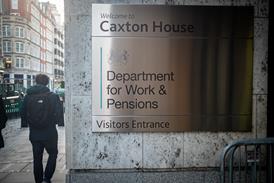Roundtable: LCP's Andy Cheseldine, Legal & General Investment Management's Martin Dietz, Columbia Threadneedle's Craig Nowrie, State Street Global Advisers' Andrew Soper, Peter Sparkes of the Association of Member Nominated Trustees, and Bestrustees' Graham Wardle, debate whether the fees associated with DGFs are worth their value, in the second of this four-part roundtable series.
Andy Cheseldine: It is not simple, unfortunately. For a pure bundled product, where the provider is responsible for undercutting the cap within one product, it is relatively easy. If trustees are managing multiple funds, they probably need to target 70 basis points to stay within the cap.
If the government introduces transaction costs into the charge cap, it becomes almost impossible. We try and minimise costs for obvious reasons but it is a question of value for money, not cost.
Craig Nowrie: That is a key issue: cost versus value. The focus has been on driving cost as low as possible without actually taking a step back and quantifying value, and we are still waiting for a definition of what good value or value for money is.
Graham Wardle: The danger is the focus on cost could eventually force trustees to go down the passive route for DC and that would not be a good outcome for members.
Andrew Soper: There should be more focus from the regulator around how we achieve good outcomes.
Peter Sparkes: While a cap is good from a member’s perspective, it is still a minefield for the average member to understand.
Soper: It also means – we see this from the investment management side – you may have to do something through derivatives, rather than incurring explicit cost, simply to manage the charge cap. The product may not generate the same overall return and this may not be desirable.
Martin Dietz: I have a slightly different view. There definitely are good active funds but, especially in DC, it is too risky to rely on a star fund manager calling the next big market drawdown.
On the other hand, you can create something better than standard equities within this charge cap by using diversification to its full potential.
Cheseldine: My argument with the charge cap is that it does not necessarily provide better value for money across the board. A charge cap of 75bp for a 25-year-old is probably excessive.
However, when you get to somebody who is two or three years from retirement and needs more protection, I would happily see charges above the charge cap. The problem is it has been applied as an average.
The charge cap does not necessarily provide better value for money across the board. A charge cap of 75bp for a 25-year-old is probably excessive
Andy Cheseldine, LCP
Soper: The cap is really going to cause managers to focus on some of the key drivers of returns. Perhaps more on the asset allocation and dynamically managing it than stock selection.
Nowrie: We have limited our ongoing charges figure to 50bp for both active management and active underlying, given that we took a view on where the market was going in terms of cost.
Cheseldine: At-retirement and post-retirement are both difficult. The cap only applies to those in the default fund at the moment. It is not possible to have a cap for non-default options and by definition post-retirement has to be non-default as we don’t know what the investment mix should be.
We could deconstruct the current cap and say it should be no more than 30bp for admin and 50bp for investment with a total of no more than 75bp.
Soper: The challenge with the charge cap is only on the default and if everybody takes the default, then what is the point? People here simply do not engage, but perhaps that will change and then there will be more scope to vary the options.
Cheseldine: So at what point should a government intervene and is it just for their own tax purposes?
Soper: In the US, the reality is that people are quite risk-averse and take a lot less than they are able.
Sparkes: With the ability to pass on your remaining fund to your family when you meet your maker, would a default decumulation option not be sensible?
Cheseldine: We are thinking about a range of inverted target date funds – one for use if you are going to spend your money over the next five years, another for 10, 15 and so on. The member has to make a choice about not how long they will live, but how long they want their money to last.
Wardle: A complication is that an enormous percentage will have defined benefit pots as well, so their decisions will be very different.
Dietz: Twenty years from now, most pensioners will have to rely on their DC pension in retirement. If people use drawdown as their main route to income, this defines a specific risk profile and we can do things that eliminate some of these risks.
There are alternative decumulation strategies though and there is going to be a bit of a trial and error to identify what people want.
Soper: Technology may help in the management of risk, but I still think it is going to be very difficult to expect the end customer to make those choices. It is not a trivial calculation to determine how the fund is sustainable over whichever time period is defined.
It is just too complicated out there for the average member, and that is why the majority of members are all in default
Peter Sparkes, AMNT
Pensions Expert: How you would like to see the regulator, or the government tackle this issue?
Cheseldine: Joined-up would be nice.
Wardle: Rather than just political point-scoring.
Sparkes: Simplification. It is just too complicated out there for the average member, and that is why the majority of members are all in default.
Soper: Being in the default is not such a bad outcome for a lot of people. If it was, we would need to rethink how those defaults were designed, rather than just telling them they need to move their investments.
Wardle: As far as trustees are concerned, if you can get a default that works fairly well for 80 per cent of the membership, that’s the most you are going to get.
Pensions Expert: If the cap is reduced further, will that not gradually undermine the quality of what is available to schemes?
Soper: It does not follow that if the charge cap comes down that it hits the management. But the natural conclusion is either the management has to simplify or it cannot be delivered more efficiently.
Dietz: A 50bp or 30bp total expense ratio is a standard fee for us, so we think we can do something that is attractive and cost-efficient.
Sparkes: If something is cheap, does it offer best value for money? Will it get to a point where the answer has to be no?
This roundtable series was chaired by freelance journalist Pádraig Floyd






















